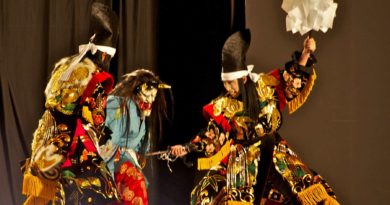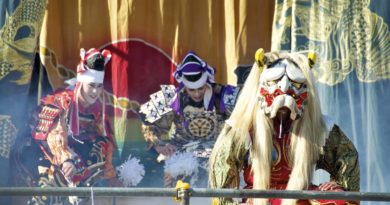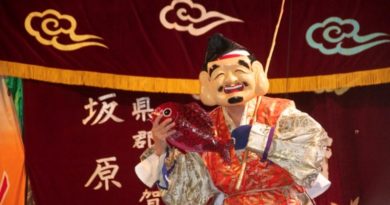An Evening of Kagura with the web-shooting ‘Earth Spider’
It took a year or two of living in Hiroshima to acquire a taste for the frenzied, slightly garish spectacle of kagura, but once the spell was cast there was, happily, no chance of breaking it. But despite having watched kagura dozens of times, at shrines, on downtown corners, or in the middle of fields deep in the countryside, I really know very little about it. I know there are various traditional performing arts practiced around the country under the name of kagura, and that the Iwami style practiced in this part of Japan has gained a nationwide following for its accessible, exuberant energy. I’d picked up the main plotlines for three or four of the most common plays. And for years, that was as far as my understanding had progressed.
So it was a real treat to be offered the chance to see kagura performed with the addition of a pre-performance English-language explanation of the story and some of its historical underpinning, subtitles for the Japanese throughout, followed by a question and answer session and the opportunity to talk directly to the players through an interpreter.
The story was Tsuchigumo, or Earth Spider, which I’d just seen performed a week earlier by a Noh troupe. The difference was stark. Where the Noh was slow and stylized to the point of self-parody, the kagura version, still carefully scripted and choreographed, felt fresh and exciting enough that my seven-year-old daughter was riveted throughout, burying her face in my side when the action got too menacing.
The dancing was fluid and powerful, the music of the drum, cymbals and flute set the heart racing, and the shouts and encouragement from musicians to dancers perfectly matched the action onstage. And we haven’t even mentioned the paper streamers yet. When the villain of the piece, a demon spider vanquished years earlier and driven into hiding in the mountains, cast aside its disguise to attack the unsuspecting Lord Raiko, the spiderman-style flurry of “web” exploding from the demon’s hands had all but buried the audience in fine strands of paper by the end of the piece.
It was all terrific fun. The audience (nearly all visitors from overseas) was enthralled, and the story, simple enough when translated, would have been largely incomprehensible without the English subtitles appearing on a screen set beside the stage. The Kinsho Kagura Troupe, from northern Hiroshima prefecture, were fantastic. You had the sense that these people really loved doing this, and especially loved doing it with one another.
Their leader clearly enjoyed answering questions and introducing his performers afterward. Children were ushered onstage to try flinging paper webbing, and one older stagehand popped a respectably large piece of dry ice in his mouth and blew vapor through his nose at us.
My daughter slipped into a robe that weighed as much as she did and posed for a photo with the demon himself, slightly wobbly left horn and all. Honest, down-to-earth entertainment. If I were a traveler to Japan, I’d be thrilled to come across something like this, and the audience, speaking (as far as I heard) French, German, Danish, Korean and English in a variety of accents, were all smiles as they left the theater.
I’ll definitely be back. The ¥1000 admission fee is a stunning bargain for Japan, and the Kinsho Kagura leader said they have fifteen plays memorized. The website lists another fifteen troupes who perform here as well. The math is promising. By this time next year, I hope to know a great deal more about the Iwami kagura repertoire than I do today. The only drawback is the indoor setting. I love kagura best at night, and outside, with a slightly inebriated festival crowd urging on the performers. If they could move the plays out onto the lawn of Shukkei-en Garden, and invite the crows and cicadas to take their proper part in things, it would be magic. But that may be asking too much. It’s already a wonderful chance to see this utterly captivating traditional art performed at the highest level, and with the added bonus of understanding what you’re seeing. Don’t miss it.





